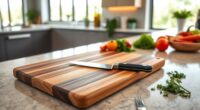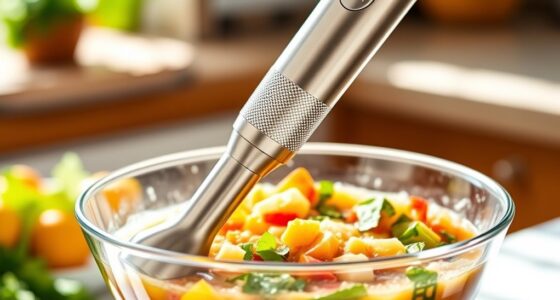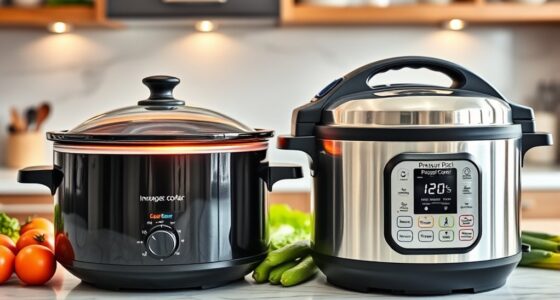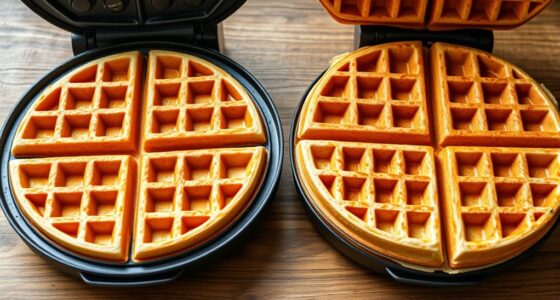Professional kitchens avoid glass top stoves because they’re too fragile for demanding use. The surfaces can crack, shatter, or stain easily under heavy pots or accidental impacts. They also don’t handle high temperatures well and can be unsafe with hot spots and uneven heating. Cleaning can be a hassle, and heavy cookware often slips or damages the surface. Want to understand more about why they’re not suitable for commercial settings? Keep exploring to discover all the reasons.
Key Takeaways
- Glass top stoves are prone to damage, cracks, and shattering under heavy or high-volume use.
- They lack durability and stability needed to handle commercial-grade cookware safely.
- Cleaning and maintenance are complex, with increased risk of scratches, stains, and thermal shock.
- Glass surfaces cannot withstand the high heat and rapid temperature changes common in professional kitchens.
- Limited size and slower heating make them unsuitable for the efficiency demands of commercial food preparation.
Susceptibility to Damage and Breakage

Glass top stoves, while sleek and modern, are more prone to damage and breakage than traditional coil burners. You need to be extra careful when handling pots and pans on these surfaces, as even a slight bump or drop can cause cracks or chips. Unlike metal coil burners, glass stoves lack the durability to withstand impacts from heavy or uneven cookware. Spills, especially sugary or acidic substances, can also stain or weaken the surface over time, increasing the risk of cracks. Daily usage in a busy kitchen amplifies these vulnerabilities, making damage more likely. Additionally, the lack of robustness makes them susceptible to chips and shattering under stress. If you’re not vigilant, a small mishap can turn into costly repairs or replacements. Proper maintenance and handling are essential to extend the lifespan of these surfaces and prevent costly damages. Incorporating mindful usage practices can further help in minimizing accidental impacts and preserving the integrity of the stove. Furthermore, understanding the vulnerabilities of glass surfaces can help you adopt better safety precautions and avoid unnecessary expenses.
Challenges With Heat Resistance and Safety
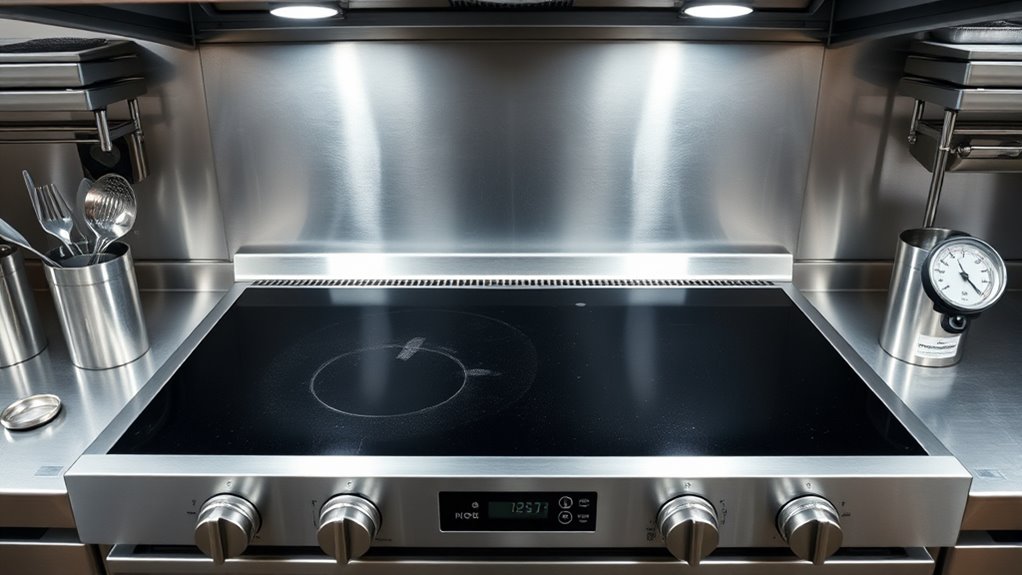
Although glass top stoves offer a sleek appearance, they present significant challenges when it comes to heat resistance and safety. The glass surface can crack or shatter under high heat or sudden temperature changes, risking injury and equipment damage. Additionally, hot spots can occur, leading to uneven cooking and potential burns. You also need to be cautious of overheated cookware, which can cause the glass to weaken or break. To clarify these risks, consider the table below:
| Issue | Explanation |
|---|---|
| Cracking/Shattering | Sudden temperature changes cause glass to break |
| Uneven Heating | Hot spots increase risk of burns and poor cooking |
| Overheating Risks | Excessive heat weakens the glass surface |
Furthermore, improper use or cleaning of glass top stoves can exacerbate these issues, emphasizing the importance of following manufacturer guidelines and understanding the personal finance management principles such as regular reviews and adjustments to ensure safe and effective use. Being aware that heat resistance varies across different types of glass can also help prevent accidental damage and accidents. Proper cleaning routines and cautious handling are essential to maintaining the integrity of the stove and preventing damage. Additionally, incorporating proper maintenance routines can extend the lifespan of the stove and ensure safety.
Difficulties in Cleaning and Maintenance

Cleaning a glass top stove can be challenging because its smooth surface readily shows smudges, spills, and stains, demanding frequent maintenance to keep it looking pristine. You’ll need to wipe it down after each use to prevent buildup, which can be time-consuming and frustrating. Even small spills can become stubborn if not cleaned immediately, and burnt-on residue may require specialized cleaners or scrubbing. Regular maintenance involves using non-abrasive cloths and avoiding harsh chemicals that could scratch or damage the surface. Over time, scratches and discoloration can develop, making it look worn and uneven. This ongoing upkeep demands diligence and patience, which can be impractical in a busy professional kitchen where quick, effective cleaning is essential. Additionally, the susceptibility of glass surfaces to scratches can compromise safety and durability trustworthiness, highlighting why professional kitchens prefer alternative cooking surfaces. Moreover, the material properties of glass make it more prone to thermal shock and breakage under heavy use, further emphasizing the need for durable alternatives.
Limitations in Handling Heavy and Hot Cookware

Handling heavy and hot cookware on a glass top stove can be challenging because the smooth surface offers limited grip and stability. You might find it difficult to move or slide heavy pots and pans without risking scratches or spills. The weight of thick, hot cookware increases the chance of slipping, which can cause accidents or damage the glass surface. Additionally, lifting hot, heavy pots requires extra caution to avoid burns or dropping them. Unlike traditional stoves with raised grates, glass tops lack support for sturdy handling. This makes it harder to manage large, weighty cookware safely and efficiently. Using Proper handling techniques and the use of appropriate tools can help mitigate these risks. Moreover, the material of cookware can influence how easily it can be managed on a glass surface. Selecting cookware with non-slip bases can further improve safety and handling ease on glass cooktops. Being aware of tuning tips specific to certain cookware types can also enhance safety and performance.
Incompatibility With Commercial Kitchen Demands

Glass top stoves often fall short of the demands of commercial kitchens because they lack the durability, speed, and versatility needed for high-volume cooking. They can’t handle the intense, continuous use required in a busy kitchen environment. Their sensitive surfaces are prone to scratches and cracks under heavy cookware or accidental impacts. Additionally, they often don’t heat as quickly or evenly as professional-grade equipment, slowing down service. Their limited size and configuration make it difficult to cook multiple dishes simultaneously. You also lose flexibility since they can’t accommodate diverse cookware types or adapt to changing menu needs. Overall, their design simply isn’t built for the relentless pace and rigorous demands of a professional kitchen. Furthermore, they typically lack the energy efficiency features necessary to manage the high energy consumption in commercial settings.
Frequently Asked Questions
Are Glass Top Stoves Suitable for High-Volume Cooking Environments?
Glass top stoves aren’t suitable for high-volume cooking environments because they can’t handle the intense, constant heat that professional kitchens demand. You’ll find that their surfaces are fragile, prone to cracking, and difficult to clean after heavy use. The heat distribution isn’t as even as professional-grade equipment, which can compromise your cooking quality and speed. For these reasons, you should opt for durable, high-performance stoves designed for commercial kitchens.
How Do Glass Top Stoves Impact Kitchen Hygiene Standards?
Imagine a busy kitchen where every surface needs to stay spotless. Glass top stoves can challenge your hygiene standards because their smooth surfaces trap food spills and grease easily, making cleaning difficult. You might find it hard to keep them sanitary during high-volume cooking, risking contamination. For maintaining strict hygiene, professional kitchens prefer more durable, easy-to-clean options, ensuring safety and cleanliness at all times.
Can Glass Top Stoves Withstand Commercial Kitchen Wear and Tear?
You might wonder if glass top stoves can handle the demanding environment of a commercial kitchen. While they look sleek, they often can’t withstand heavy, continuous use like professional-grade equipment. The glass can crack or break under high heat, and scratches or stains may develop quickly. For durability and longevity, you’re better off with rugged, heat-resistant stoves designed specifically for the intense wear and tear of a commercial setting.
Do Glass Top Stoves Require Special Training for Professional Chefs?
You might think glass top stoves are as simple as flipping a switch, but they actually require special training for professional chefs. You need to learn how to handle spills carefully, avoid dragging heavy pots that could crack the surface, and understand the delicate temperature controls. Without this knowledge, even a small mistake could turn your sleek stove into a shattered mess. Proper training guarantees you keep your equipment safe and efficient.
What Are the Energy Efficiency Differences Between Glass and Traditional Stoves?
When comparing energy efficiency, glass top stoves often transfer heat more evenly, reducing energy waste. However, traditional stoves with open flames or coil burners can be more responsive and efficient with rapid temperature changes. You might notice that glass tops take longer to heat up initially but maintain heat well. Overall, your choice depends on your cooking style—glass tops offer consistency, but traditional stoves can be more adaptable in energy use.
Conclusion
You can think of glass top stoves like delicate glass figurines—they look beautiful but aren’t built for the rough-and-tumble world of professional kitchens. Their fragility, heat limitations, and maintenance challenges turn them into liabilities rather than assets. In a busy kitchen, you need equipment that’s as tough as steel and as reliable as a well-oiled machine. That’s why seasoned chefs stick to traditional, durable stoves—they’re the sturdy backbone of every successful culinary operation.

